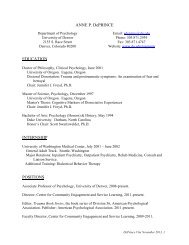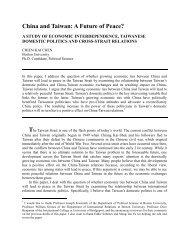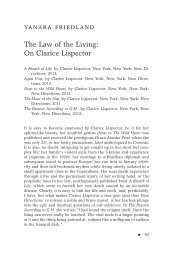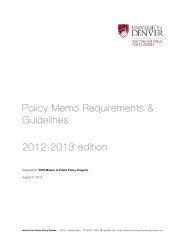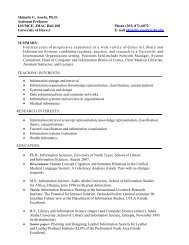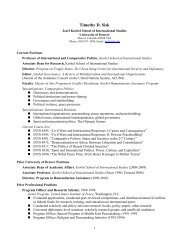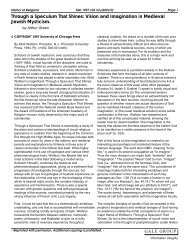View slides from this lecture.
View slides from this lecture.
View slides from this lecture.
You also want an ePaper? Increase the reach of your titles
YUMPU automatically turns print PDFs into web optimized ePapers that Google loves.
9/7/2013<br />
Andy’s Story<br />
I first met Andy more than ten years<br />
ago, when he walked into my office<br />
along with his father. He explained<br />
that he was now running a successful<br />
landscaping business with three<br />
employees. Andy’s father shook his<br />
head and said, “I don’t know if I’ll ever<br />
forgive those doctors for being so<br />
negative.”<br />
Andy’s Story<br />
His father explained, “When Andy was<br />
first hurt, the doctors told us he<br />
probably would not live through the<br />
night. He was in the hospital for<br />
almost two months. A few days before<br />
discharge, the doctors told us he<br />
probably would never be able to walk.<br />
They were even more certain he would<br />
never hold a job.”<br />
Andy’s Story<br />
Andy recently stopped by my<br />
office again, <strong>this</strong> time with<br />
his wife. I talked with them<br />
both for a long time, listening<br />
carefully as they filled me in<br />
on the last ten years.<br />
Andy’s Story<br />
They met in church and were<br />
married after dating for more<br />
than a year. Soon after their<br />
third anniversary the first of<br />
their two children was born.<br />
Three years later their son<br />
was born.<br />
Andy’s Story<br />
Andy’s wife smiled and held his hand as she<br />
talked. She described him as a wonderful<br />
husband, a good provider, and a loving and<br />
patient father. His wife said, “His memory is<br />
not the best so he writes everything down.”<br />
She looked at him and said, “He’s never<br />
forgotten a birthday or anniversary.<br />
Not even once.”<br />
1
9/7/2013<br />
The Case of Bill<br />
Three years ago, 28 year old Bill sustained a severe<br />
brain injury in a high speed motor vehicle collision. On<br />
admission to the emergency room, GCS was 7. Head CT<br />
revealed a right temporal contusion and a large left<br />
parietal intracranial hemorrhage with a depressed skull<br />
fracture. He underwent a left craniectomy with skull<br />
fracture debridement and ICH removal. Hospitalized for<br />
more than a month, Bill was discharged home in the<br />
care of his wife.<br />
The Case of Tom<br />
Three years ago, 28 year old Tom sustained a severe<br />
brain injury in a high speed motor vehicle collision. On<br />
admission to the emergency room, GCS was 7. Head CT<br />
revealed a right temporal contusion and a large left<br />
parietal intracranial hemorrhage with a depressed skull<br />
fracture. He underwent a left craniectomy with skull<br />
fracture debridement and ICH removal. Hospitalized for<br />
more than a month, Tom was discharged home in the<br />
care of his wife.<br />
The Case of Bill<br />
Unemployed and Living with His Parents<br />
Three years after his injury, Bill now lives with his parents and they<br />
now have a turbulent relationship. His wife and two young children<br />
are living without him in the home they once shared. After<br />
repeatedly cursing and yelling at them and punching holes in the<br />
wall, Bill’s wife obtained a court order forcing him out of their home.<br />
Despite numerous requests <strong>from</strong> his wife and parents, Bill had<br />
declined to see a doctor or counselor and denied having problems he<br />
couldn’t handle himself. Bill is now unemployed. He went back to<br />
his old job as a landscaper and three weeks later was fired for<br />
repeatedly arguing with customers. Bill found several other jobs, but<br />
wasn’t able to hold any of them for more than a short time. Angry, he<br />
told his parents, “my life has been ruined forever by <strong>this</strong> accident.”<br />
The Case of Tom<br />
Working and Living with His Wife and Children<br />
Three years after his injury, Tom was living with his wife and two<br />
young children. Soon after returning home, he began to have bouts<br />
of depression. With encouragement <strong>from</strong> his wife, he saw his family<br />
doctor who provided medication and referred him to a counselor for<br />
weekly sessions. Tom also began to attend a monthly brain injury<br />
support group. He learned that sharing his thoughts and feelings with<br />
others helped him adjust and function. Tom tried going back to work<br />
full‐time as a landscaper and initially had problems with fatigue and<br />
headaches. With support <strong>from</strong> his supervisor and colleagues, Tom<br />
backed down to a part‐time schedule. After eight months, he was<br />
gradually able to resume a full‐time schedule. Tom recently received<br />
a sizable raise. Smiling, his supervisor told him, “I know I can trust<br />
you. You never complain and you’re the hardest working man here.”<br />
What Bill said….<br />
• To avoid disappointment, I<br />
imagine the worst thing<br />
that can happen.<br />
• I’ll get stronger if I trust<br />
no one and solve my<br />
problems by myself.<br />
• My future has been<br />
permanently destroyed by<br />
<strong>this</strong> trauma.<br />
• When something goes<br />
wrong, I fear that I’ll<br />
never recover.<br />
What Tom said…<br />
• I’m usually optimistic<br />
and see problems as<br />
temporary.<br />
• I have good friends I can<br />
talk to who help me<br />
out.<br />
• I’ve been made stronger<br />
and better by <strong>this</strong><br />
difficult experience.<br />
• When bad things<br />
happen, I’m not down<br />
for long<br />
2
9/7/2013<br />
What Bill said….<br />
• I’ve learned that most<br />
people have nothing good<br />
or helpful to say.<br />
• I don’t like who I am now.<br />
My self‐confidence has<br />
vanished.<br />
• Mistakes only lead to<br />
depression and more<br />
mistakes.<br />
• I choose to be around<br />
people who are just like me.<br />
• If my first solution to a<br />
problem fails, I usually<br />
panic.<br />
What Tom said…<br />
• I listen carefully and<br />
consider other people’s<br />
opinions.<br />
• I know my strengths and<br />
work to build my selfconfidence.<br />
• I do my best to learn <strong>from</strong><br />
mistakes and try to do<br />
better next time.<br />
• I enjoy being around<br />
different kinds of people.<br />
• If my first solution to a<br />
problem fails, I try to find<br />
another solution.<br />
What is Resilience?<br />
Definition: “… the ability to withstand<br />
and rebound <strong>from</strong> disruptive life<br />
challenges… involves dynamic<br />
processes fostering adaptation within<br />
the context of significant adversity.”<br />
From Walsh, F. (2003) Family Process, 42 (1).<br />
Defining<br />
Resilience, Resilient, and Resiliency<br />
o Cope well in the face of ongoing disruptive change<br />
o Maintain good health and energy in the face of<br />
constant pressure<br />
o Overcome adversities, bounce back <strong>from</strong> setbacks<br />
o Change to a new way of working or living when<br />
maintaining the old way is not possible<br />
o Do all <strong>this</strong> without behaving in harmful or<br />
dysfunctional ways<br />
Goals in Learning to be Resilient<br />
o Remain calm under pressure<br />
o Improve creative, analytical, and practical problem<br />
solving skills<br />
o Maintain optimism, humor, and positive feelings in the<br />
face of challenges<br />
o Avoid thinking of one’s self (and others) as a victim<br />
o Be self‐reliant and socially responsible<br />
o Understand that learning leads to a better life<br />
o Derive good fortune <strong>from</strong> misfortune<br />
From Siebert, A., The Resiliency Advantage, © 2005<br />
Al Siebert (2005)<br />
“When resilient people have their lives<br />
disrupted they handle their feelings in<br />
healthy ways. They allow themselves to feel<br />
grief, anger, loss, and confusion when hurt<br />
and distressed, but they don’t let it become a<br />
permanent feeling state… They are examples<br />
of Nietzsche’s statement, ‘That which does<br />
not kill me makes me stronger’.”<br />
The Resiliency Advantage<br />
Attack<br />
Al Siebert, 2003<br />
Disruptive<br />
Change<br />
Numb<br />
Upset<br />
Thrive<br />
Resile<br />
Cope<br />
Victim<br />
3
9/7/2013<br />
Laying the Groundwork for Resilience<br />
• Life change is possible<br />
• Thoughts and emotions are essential<br />
components of our humanity<br />
• Thinking accurately is essential<br />
• Focus on strengths while avoiding a<br />
tendency to focus on the negative<br />
Life Change is Possible<br />
“… people can change their lives. This is a powerful<br />
concept, a modern one. The notion that humans are not<br />
bound and gagged by the fallout of their early childhoods,<br />
that they can change their behavior at any time in their<br />
lives, seems such a truism to some people<br />
today. Historically, people have believed<br />
that lasting change was not possible.<br />
Even now, many people cling to the<br />
notion that the first few years of life<br />
determine everything about a person<br />
and her future.”<br />
From Reivich & Shatte, The Resilience Factor, © 2002<br />
Thoughts and Emotions<br />
“.. Over the years he (Aaron Beck) came to<br />
recognize what an enormous body of research<br />
now confirms – cognitions cause emotions, and<br />
emotions matter in determining who remains<br />
resilient and who succumbs… The success of<br />
cognitive therapy highlights what many of us<br />
already suspect –that our thoughts and<br />
emotions are the very core of who we are; that<br />
they represent our essential humanity.”<br />
From Reivich & Shatte, The Resilience Factor, © 2002<br />
Thinking Accurately<br />
“.. Realistic optimism is the ability to maintain a positive<br />
outlook without denying reality, actively appreciating the<br />
positive aspects of a situation without ignoring the<br />
negative aspects. It means aspiring and hoping for<br />
positive outcomes, and working toward those outcomes<br />
without assuming that these outcomes are a forgone<br />
conclusion. Realistic optimism does not assume that good<br />
things will happen automatically. It is the belief that good<br />
things may happen and are worth pursuing, but that<br />
effort, problem solving, and planning are necessary to<br />
bring them about.”<br />
From Reivich & Shatte, The Resilience Factor, © 2002<br />
Positive Psychology<br />
“.. This new social science aims to create an<br />
empirical body of knowledge of optimal human<br />
functioning… Two basic goals: To increase<br />
understanding of the human strengths through<br />
the development of classification systems and<br />
methods to measure these strengths; To infuse<br />
<strong>this</strong> knowledge into effective programs and<br />
interventions design to build strengths rather<br />
than remediate weaknesses.”<br />
From Reivich & Shatte, The Resilience Factor, © 2002<br />
Strength‐Based Care Models<br />
o “Disciplines which have embraced a shift<br />
toward strength‐based models of care<br />
have done so for both practical and<br />
humanistic reasons<br />
o Researchers (e.g., Duncan, 2010) have<br />
established that a dominant factor in<br />
positive therapeutic outcomes is a therapy<br />
client’s orientation toward hope and<br />
change.<br />
Godwin & Kreutzer, Brain Injury, 2013<br />
4
9/7/2013<br />
Strength‐Based Care Models<br />
o In fact, empirical support demonstrates<br />
that 30% or more of therapy‐based<br />
growth can be attributed to a client’s<br />
ability to be optimistic and flexible.<br />
o Processes designed to facilitate the<br />
promotion of resilient traits are<br />
tied to successful outcomes.”<br />
Godwin & Kreutzer, Brain Injury, 2013<br />
Focus on Strengths<br />
“Resilience is the basic strength underpinning<br />
all the positive characteristics in a<br />
person’s emotional and psychological<br />
makeup. A lack of resilience is the major<br />
cause of negative functioning. Without<br />
resilience there is no courage, no<br />
rationality, no insight. It is the bedrock on<br />
which all else is built.”<br />
From Reivich & Shatte, The Resilience Factor, © 2002<br />
Rationale for Investigating Resilience<br />
• The profile of a resilient population after TBI has<br />
not been established<br />
• To date, the natural process of resilience<br />
development following TBI has not been<br />
investigated<br />
• Identification of correlating variables and the<br />
path to resilience can strengthen interventions<br />
designed to promote resilience after TBI<br />
Traits and Skills<br />
Researchers in the field of resilience have<br />
determined that:<br />
a. the skills that are associated with a resilient and<br />
adaptive response to trauma are neither<br />
“superhuman” nor extraordinary; and<br />
b. resilient skills can be initiated and/or<br />
strengthened in individuals who have<br />
previously demonstrated non‐resilient profiles.<br />
Common TBI Challenges and<br />
Skills Necessary for Resilience<br />
Research project partly funded by the U.S. Department<br />
of Education, National Institute on Disability and<br />
Rehabilitation Research (NIDRR) #H133A120031.<br />
Common TBI Deficits and Challenges<br />
Anxiety, depression<br />
Skills Necessary for Resilience<br />
Even temperament, emotional<br />
stability<br />
Survivor focus on deficits, frequent Positive outlook, optimism<br />
comparisons to pre‐injury functioning<br />
Irritability, aggressive behaviors Self‐regulatory skills and eventempered<br />
behaviors<br />
Discomfort with socialization Social perception, arousal of liking<br />
response in others<br />
Impaired self awareness<br />
Insightful modification of behavior<br />
Cognitive deficits, impaired executive Good problem solving skills<br />
functioning<br />
Diminished communication skills Effective communication<br />
5
9/7/2013<br />
1. Assumptions Underlying the Resilience<br />
and Adjustment Intervention<br />
• Successful survivorship is based in<br />
individual resilience.<br />
• Survivors who embody, or who learn to<br />
adopt traits identified as key to resilient<br />
living will find increasing success in<br />
their recovery and growing satisfaction<br />
with their postinjury lives.<br />
2. Assumptions Underlying the Resilience<br />
and Adjustment Intervention<br />
• Achieving postinjury emotional<br />
wellness requires a clear<br />
understanding of injury‐related<br />
symptoms, commonly encountered<br />
challenges, and recovery processes.<br />
3. Assumptions Underlying the Resilience<br />
and Adjustment Intervention<br />
• A key feature of resilience is<br />
developing insight into one’s own<br />
behavioral response to trauma.<br />
• Survivors who are more aware of<br />
their strengths and limitations are<br />
more likely to lead productive and<br />
meaningful lives.<br />
4. Assumptions Underlying the Resilience<br />
and Adjustment Intervention<br />
• Resilient individuals are skillful at<br />
problem solving, goal setting,<br />
communicating, and managing stress<br />
and intense emotions.<br />
• Helping survivors develop these skills<br />
benefits their ability to be productive<br />
and maintain quality relationships.<br />
5. Assumptions Underlying the Resilience<br />
and Adjustment Intervention<br />
• Survivors are more likely to improve<br />
when they develop resilient traits,<br />
such as being actively engaged in<br />
recovery, and are able to maintain a<br />
positive outlook.<br />
Goals of the RAI Program<br />
1. To provide survivors with fundamental<br />
information about common symptoms and<br />
challenges after TBI<br />
2. To help survivors develop core abilities, enabling<br />
them to more effectively problem solve and<br />
efficiently achieve personal goals<br />
3. To teach coping strategies that facilitate the<br />
process of emotional recovery, helping survivors<br />
to feel better about themselves, their lives, and<br />
their relationships<br />
6
9/7/2013<br />
Goals of the RAI Program<br />
4. To teach survivors effective communication<br />
skills, enabling them to develop effective longterm<br />
support systems<br />
5. To instill hope and a positive outlook by<br />
identifying progress and personal strengths,<br />
and helping survivors access community<br />
resources<br />
<br />
<br />
<br />
RAI Implementation<br />
Five week, seven session format with two or<br />
three topics covered during each sixty minute<br />
session<br />
Total of 16 topics covered via self‐assessment,<br />
discussion, and structured learning<br />
experiences<br />
Sessions implemented hierarchically; earlier<br />
topics provide foundation for later topics<br />
RAI Implementation<br />
Time span between sessions allows for<br />
homework completion, reflection, trying<br />
out strategies and solutions to problems<br />
Sessions conducted by single qualified<br />
therapist with single survivor<br />
Resilience and Adjustment Intervention<br />
Accommodations<br />
Written materials provided in large print<br />
to accommodate visual impairments.<br />
Materials written at a 5 th grade level for<br />
people with limited reading skills.<br />
Information is presented in writing,<br />
orally, and visually for people with<br />
different learning styles.<br />
No doubt, each<br />
patient, each family<br />
member, and each<br />
family is unique.<br />
Yet, research and clinical<br />
experience indicates that<br />
most survivors have<br />
similar concerns and many<br />
face similar challenges.<br />
7
9/7/2013<br />
Curriculum Based Approach<br />
• Education regarding common<br />
challenges, issues, and concerns<br />
• Psychological support<br />
• Skill building abilities associated with<br />
improvement in the targeted domain<br />
• Components adapted <strong>from</strong> validated<br />
Brain Injury Family Intervention<br />
8
9/7/2013<br />
Resilience and Adjustment Intervention<br />
Session I<br />
Understanding the Effects of Brain Injury<br />
1. Understand the typical consequences of<br />
brain injury<br />
2. Appreciate the difference between<br />
emotional and physical recovery<br />
3. Cope effectively with loss and change<br />
Resilience and Adjustment Intervention<br />
Session II<br />
Active Engagement in Recovery<br />
4. Realize the important role you have in<br />
your own recovery<br />
5. Recognize what you can do to help<br />
yourself and feel better<br />
9
9/7/2013<br />
Resilience and Adjustment Intervention<br />
Session III<br />
Setting Reasonable Goals<br />
6. Appreciate that success is relative<br />
7. Improve your ability to be patient<br />
8. Understand and implement effective<br />
goal setting strategies<br />
Resilience and Adjustment Intervention<br />
Session IV<br />
Solve Problems Effectively<br />
9. Learn and use more effective<br />
problem solving strategies<br />
Resilience and Adjustment Intervention<br />
Session V<br />
Managing Stress, Anger, and Other Intense<br />
Emotions<br />
10. Monitor and manage stress more<br />
effectively<br />
11. Better manage intense emotions<br />
including frustration, anger, and fear<br />
10
9/7/2013<br />
Resilience and Adjustment Intervention<br />
Session VI<br />
Communicating Effectively and Rebuilding<br />
Relationships<br />
12. Rebuild relationships<br />
and overcome loneliness<br />
13. Learn and apply more effective<br />
communication strategies<br />
14. Develop strategies for comfortably<br />
discussing injury with others<br />
Resilience and Adjustment Intervention<br />
Session VII<br />
Communicating Effectively and Rebuilding<br />
Relationships<br />
15. Avoid a negative focus, feeling guilty, or<br />
blaming others<br />
16. Appreciate positive aspects of your new<br />
life and develop a positive attitude<br />
11
9/7/2013<br />
Investigating Resilience:<br />
The Connor‐Davidson Resilience Scale<br />
Review of existing resilience inventories<br />
suggests the CD‐RISC is the most<br />
effective measurement tool available<br />
Established excellent psychometric<br />
properties, e.g. reliability, internal<br />
consistency, and construct validity<br />
CD‐RISC<br />
• 25‐item and 10‐item versions, both<br />
empirically validated<br />
• Statements ranked on a 0–4 frequency scale:<br />
0 ‐Not true at all; 1 ‐Rarely true; 2 ‐Sometimes<br />
true; 3 ‐Often true; 4 ‐True nearly all of the<br />
time<br />
• Respondents evaluate the veracity of<br />
statements as they pertain to the last month<br />
www.connordavidson‐resiliencescale.com<br />
CD‐RISC Framework<br />
Assessment via a resilience model based<br />
on hardiness and persistence, specifically:<br />
o Not giving up o Tolerating pressure<br />
o Coping with o Overcoming negative<br />
unexpected events outcomes<br />
o Tolerating stress o Coping with<br />
o Overcoming illness & unpleasant feelings<br />
hardship<br />
www.connordavidson‐resiliencescale.com<br />
Connor‐Davidson Resilience Scale<br />
Mean Scores for Specific Populations<br />
PTSD<br />
Generalized Anxiety<br />
Psychiatric Patients<br />
Primary Care Patients<br />
US General Population<br />
Connor & Davidson, 2003<br />
0<br />
20<br />
40<br />
60<br />
80<br />
100<br />
12
9/7/2013<br />
Virginia Commonwealth University<br />
Medical Center<br />
Our work should be guided by the<br />
experiences of the people we serve, our<br />
perception of their needs, and our sense<br />
of the most important things we can do<br />
to meaningfully improve their lives.<br />
JSK<br />
Jeffrey S. Kreutzer, Ph.D., ABPP<br />
jskreutz@vcu.edu<br />
www.tbinrc.com<br />
Department of Physical Medicine and Rehabilitation<br />
VCU Box 980542, Richmond, VA 23298‐0542<br />
Ph. 804 828‐3704<br />
13



